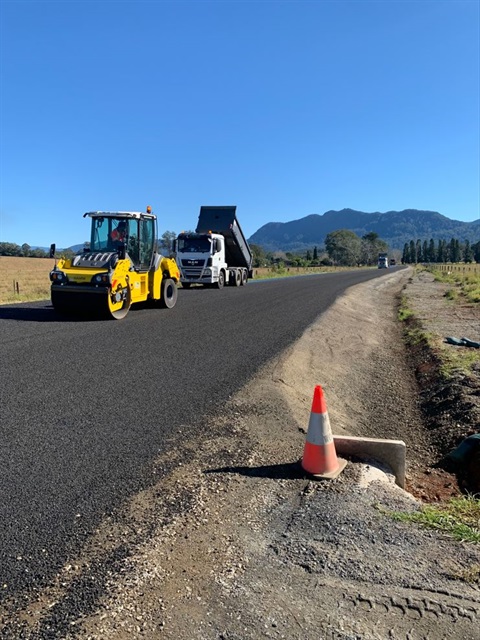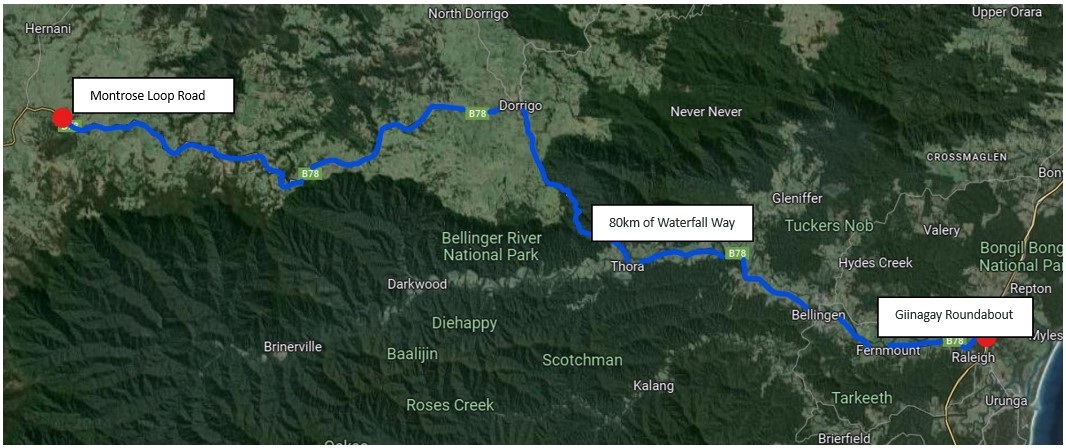Waterfall Way Upgrade

Waterfall Way provides a 170 kilometre east – west connection between the Pacific Highway at Raleigh and the New England Highway at Armidale. It connects rural communities to the urban centres of Coffs Harbour and Armidale.
Bellingen Shire Council maintains approximately 80km of Waterfall Way under the RMCC from the northern Roundabout off the Giinagay Roundabout to the crossing near Montrose Loop Road (between Deer Vale & Hernani)
An estimated 42,377 people live in the vicinity of Waterfall Way, with about 33,000 of this number in the major regional towns and centres including Bellingen (6,168), Dorrigo (3,250) and Armidale (23,967) (2021 ABS census). The region encompasses the traditional lands of the Gumbaynggirr, Nganyaywana and Dunghutti people.

Traffic volumes along the Waterfall Way vary in the rural sections from about 900 vehicles per day, between Dorrigo and Ebor, to more than 7,500 vehicles per day between the Pacific Highway and Bellingen.
Waterfall Way is part of the State Road Network and Transport for NSW are the Road Authority. Bellingen Shire Council has been engaged by Transport for NSW under the Road Maintenance Council Contracts (RMCC) to carry our routine maintenance and specific road upgrade projects. TfNSW also completes works on Waterfall Way without the involvement of Bellingen Shire Council.
In the past year, BSC has successfully delivered several projects on Waterfall Way including:
- Routine maintenance activities
- Annual reseal program
- Culvert replacements
- End Terminal guardrail upgrades
- Slope remediation works on Dorrigo Mountain
- Asphalt rehabilitation in the center of Dorrigo Township
- Completion of the major construction project from West Bellingen to Roses Creek
- Commencement of the next major construction project from Wills Bridge to Roses, focusing on earthworks, culvert replacements, and widenings
We extend our sincere thanks to all road users for their patience and understanding during roadwork projects. Your cooperation ensures the safety of both workers and travelers, and we all benefit from the improvements made.
Projects for this Year This year's projects include:
- Continuation of routine maintenance activities
- Near completion of the annual reseal program, with consistent progress from West Bellingen to Boggy Creek
- Continued work on the major construction project from Wills Bridge to Roses, focusing on pavement activities
Future Plans While future works are not confirmed at this stage, we anticipate upcoming safety projects and upgrades throughout the network. Stay tuned for further updates as Transport for NSW prepares to release community communications
Why are we doing this work?
Waterfall Way has long been recognised as an essential road corridor for communities, tourism and agriculture. We understand that frequent and ongoing disruption due to natural disasters prevents access to jobs, education, leisure and essential services.
We are working to:
- investigate opportunities for greater resilience of the road network, which enables us to respond better to events that can’t be avoided or predicted
- restore and maintain road infrastructure including pavement, bridges, retaining walls, slopes and drainage
While we cannot eliminate disruption, such as the March 2021 and 2022 wet weather events which caused major damage and land slips between Bellingen and Dorrigo, we can improve the resilience of customer journeys, build redundancy into our networks, and keep our customers safe and informed.
What work are we doing?
Work along Waterfall Way generally falls into four categories:
- Safety
- Disaster recovery
- Journey resilience
- Maintenance
We are currently focused on delivering safety and disaster recovery work, which involves:
- widening the road
- installing or upgrading safety barriers
- intersection and road safety improvements
- installing slow vehicle passing lanes
- implementing temporary and permanent engineering solutions at land slip sites such as Myers Bluff and Thora
The PRRR of journey resilience
Resilience can be considered as the ability to withstand, adapt to and recover quickly from anticipated or unexpected shocks and stresses –now and in the future.
Improving journey resilience includes four key principles:
- Plan to prevent future journey impacts –identify and prioritise targeted maintenance activities such as improvements to drainage
- Respond and manage disruption when it occurs –use technology such as variable message signs to enhance warning systems and communicate with customers in real time
- Recover and return the network to ‘normal’ operating conditions as quickly as possible to enable customers to access the road as they would on a normal day
- Reflect, review and redefine approaches –seek continuous improvement through feedback and engagement with internal and external stakeholders
Work hours
Work hours will be between 7am and 5pm, Monday to Friday and Saturdays between 7am and 1pm. We will notify residents adjacent to work if there is a need to work outside these hours.
The project team will plan activities to minimise the impact of this work where possible and monitor any potential impacts so we can adjust our work as required.
Plan your journey
To manage safety there will be temporary traffic changes including reduced speed limits and lane closures, which may affect travel times.
You will need to plan for up to 5-minute delays at each location as they will
be controlled with traffic signals. Whenever possible, priority will be given to emergency vehicles and school buses.
Please keep to speed limits and follow the direction of traffic controllers and signs. For the latest traffic updates, you can call 132 701, visit livetraffic.com or download the Live Traffic NSW App.
Contact
If you would like to provide feedback, or have any questions and require more information about work activities, please contact the Transport for NSW project team on:
P. 1800 653 092 (toll free)
E. region.north@transport.nsw.gov.au
W. nswroads.work/waterfallway
We apologise for any inconvenience and thank you for your patience during this important work.
December 2023 - Culvert Instillation Waterfall Way